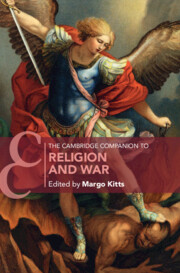Book contents
- The Cambridge Companion to Religion and War
- Cambridge Companions to Religion
- The Cambridge Companion to Religion and War
- Copyright page
- Contents
- Contributors
- Preface
- Introduction
- Part I Classical Foundations
- 1 Biblical Paradigms of War in History and Eschatology
- 2 Early Christianity and War
- 3 Fighting and Martial Valor in Islamic Thought
- 4 Hinduism and War
- 5 Buddha in the Ring of Fire
- 6 Sikhism
- 7 Religion and War in Traditional China
- 8 Buddhism and War in Premodern Japan
- Part II Just War
- Part III Religious Nationalism
- Part IV Featured Conflicts
- Index
- Cambridge Companions to Religion (continued from page ii)
- References
8 - Buddhism and War in Premodern Japan
from Part I - Classical Foundations
Published online by Cambridge University Press: 04 May 2023
- The Cambridge Companion to Religion and War
- Cambridge Companions to Religion
- The Cambridge Companion to Religion and War
- Copyright page
- Contents
- Contributors
- Preface
- Introduction
- Part I Classical Foundations
- 1 Biblical Paradigms of War in History and Eschatology
- 2 Early Christianity and War
- 3 Fighting and Martial Valor in Islamic Thought
- 4 Hinduism and War
- 5 Buddha in the Ring of Fire
- 6 Sikhism
- 7 Religion and War in Traditional China
- 8 Buddhism and War in Premodern Japan
- Part II Just War
- Part III Religious Nationalism
- Part IV Featured Conflicts
- Index
- Cambridge Companions to Religion (continued from page ii)
- References
Summary
This chapter surveys the intertwining of religion (both Buddhism and Shinto) and war in the history of Japan, including: Buddhism’s initial introduction and subservience to the state in the 6th century; the emergence of warrior-monks (J. sōhei) in the Heian era; and the role of Buddhism in the samurai-dominated medieval period. Of particular interest to Western readers will be the emphasis on samādhi-power, acquired through Zen meditation, which was cultivated among the samurai class prior to the Meiji Restoration of 1868, contributing to the fanaticism that emerged in the modern Japanese Empire.
- Type
- Chapter
- Information
- The Cambridge Companion to Religion and War , pp. 187 - 212Publisher: Cambridge University PressPrint publication year: 2023



